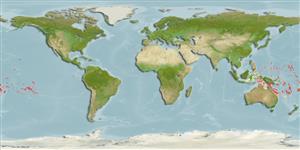Environment: milieu / climate zone / depth range / distribution range
Ecologia
marino associati a barriera corallina; distribuzione batimetrica 0 - ? m. Tropical; 16°N - 28°S
Pacific Ocean: confined around oceanic islands, ranging from the Marshalls, Gilberts, and Tonga to the Marquesan and Easter islands (Ref. 1602).
Size / Peso / Age
Maturity: Lm ? range ? - ? cm
Max length : 30.0 cm TL maschio/sesso non determinato; (Ref. 54980)
Raggi dorsali molli (totale) : 15; Raggi anali molli: 17 - 18.
Occurs in schools at the surface of lagoon and seaward reefs (Ref. 9710).
Life cycle and mating behavior
Maturità | Riproduzione | Deposizione | Uova | Fecundity | Larve
Myers, R.F., 1991. Micronesian reef fishes. Second Ed. Coral Graphics, Barrigada, Guam. 298 p. (Ref. 1602)
IUCN Red List Status (Ref. 130435: Version 2024-1)
Threat to humans
Harmless
Human uses
Pesca: di nessun interesse
Strumenti
Special reports
Download XML
Fonti Internet
Estimates based on models
Preferred temperature (Ref.
123201): 25.2 - 29.4, mean 27.8 °C (based on 641 cells).
Phylogenetic diversity index (Ref.
82804): PD
50 = 0.5000 [Uniqueness, from 0.5 = low to 2.0 = high].
Bayesian length-weight: a=0.00257 (0.00115 - 0.00574), b=3.09 (2.91 - 3.27), in cm total length, based on LWR estimates for this Genus-body shape (Ref.
93245).
Trophic level (Ref.
69278): 3.0 ±0.4 se; based on size and trophs of closest relatives
Resilienza (Ref.
120179): Alto, tempo minimo di raddoppiamento della popolazione meno di 15 mesi (Preliminary K or Fecundity.).
Fishing Vulnerability (Ref.
59153): Low vulnerability (20 of 100).
Nutrients (Ref.
124155): Calcium = 266 [60, 621] mg/100g; Iron = 0.88 [0.32, 2.78] mg/100g; Protein = 17.9 [14.9, 20.2] %; Omega3 = 0.105 [0.047, 0.308] g/100g; Selenium = 25.9 [10.6, 66.5] μg/100g; VitaminA = 230 [54, 836] μg/100g; Zinc = 1.5 [0.6, 4.2] mg/100g (wet weight);
